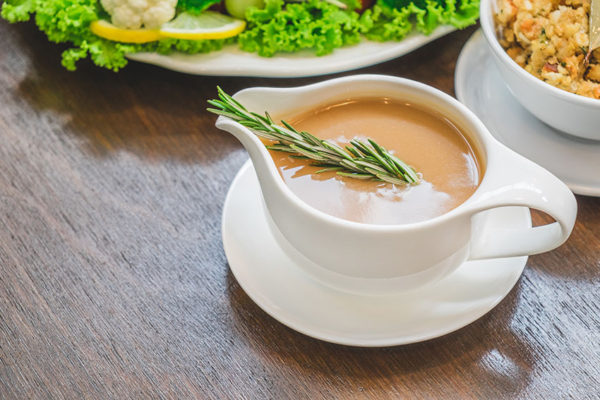This is the turkey recipe to end all turkey recipes this season. I’ve been using this method for as long as I can remember because, without fail, every time I serve it, it is moist, succulent and mouth-watering. No dry birds over here!
The simple trick in all of it? DON’T stuff your turkey, and roast it upside down (this allows for the breast meat to baste in its own juices). Yes, you heard it here first: This will yield the best turkey this side of the Christmas table, I promise you. Here’s how it’s done.

You will need:
- 14-16 pound turkey (keep the neck and giblets reserved for stock).
- Large roasting pan with trivet insert (preferably V-shaped).
- Unsalted butter
- Freshly ground black pepper and coarse sea salt
- Fresh sage, rosemary and thyme sprigs
- 1 lemon, 1 yellow onion
How to begin:
- Preheat your oven to 450 degrees. Know that every oven is different, but the general rule of thumb is 15 minutes for every pound of turkey. Important also: Unstuffed. That will come later…
- Season the entire bird with salt and freshly-cracked pepper; then stuff the inside of the bird with the lemon cut in half, the onion (peeled, chopped in half) and a big handful of the freshly-chopped herbs.
- Tie the legs together with cooking twine, and brush the entire bird: breast, legs and thighs with 4 tablespoons of melted butter.
- Put the turkey upside down on the trivet (which means breast-side down).
- Cover it loosely with tin foil and roast in the oven (at 450 degrees) for 30 minutes. After 30 minutes, turn the heat down to 350 degrees and cook with that rule mentioned above in mind: 15 minutes for every pound, ensuring you baste the bird with its own juices every 20 minutes, or so.
- The last 30 minutes, take off the tin foil(sit’s so the skin can get nice and crispy) and flip the bird over so you can now brown the breast meat (Delicious!). You can put the broiler on to brown the skin, but make sure you keep an eye on it so it doesn’t burn.
- This is critical, friends: Let the bird rest – for at least 30 minutes. It allows the juices to reincorporate into the meat making it succulent and moist when it’s time to carve and serve.
I know people tend to prefer serving red with poultry, but I’ve always been of the mind that it should be a crisp white, either a Pinot Grigio or something with more body like a Montrachet or Mersault. They Do cost more, but it is the holidays so give yourself permission to splurge a little bit.
Happy Holidays!
Gravy Recipe
You will need:
- 3-4 cups of Chicken Stock (This depends on how much gravy you want to make; the stock is its base.)
- ½ cup to 1 cup of White wine (Whatever good bottle you drink you use in your cooking also.)
- Tablespoon Dijon mustard
- 2 teaspoons (to taste) of Worcestershire sauce
- 1 tablespoon of All-Purpose flour
- Salt and pepper (to taste)

*I don’t tend to measure everything to an exact degree when it comes to savory recipes. This gravy is one I’ve made for years and these proportions work well for me!
- Heat the chicken stock in a separate pot on the stove just so it’s lightly simmering, and have a ladle handy.
- Remove the trivet from the roasting pan and place the pan with its juices on the stove on medium to low heat.
- Spoon off some of the grease that is floating at the top, but leave enough so that you can easily combine the ingredients.
- Start by sprinkling the flour over the pan juices and moving it constantly with a wooden spatula so that you won’t have any lumps.
- Get all the bits up that are stuck at the bottom, as you don’t want to miss any of the great flavours!
- Now, add a heaping tablespoon of Dijon mustard and a couple of big splashes of Worstershire sauce, freshly ground pepper, salt and, if needed. (Always taste the gravy for seasoning, as you don’t want to over salt.) Let it cook away for a few minutes.
- This is when you slowly start to add your warm chicken stock you have been simmering and, as above, keep stirring the pan so that all the juices will meld together and the flour will have a chance to thicken it without any lumps.
- Taste one more time! Does it need more pepper, more salt?
My advice with this recipe is to make more than you think you’ll need at Christmas dinner. It tastes absolutely divine with leftovers the next day!
